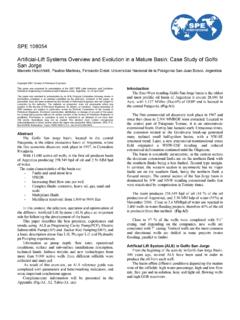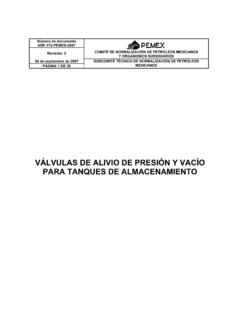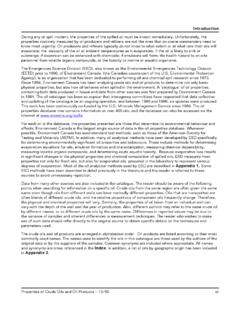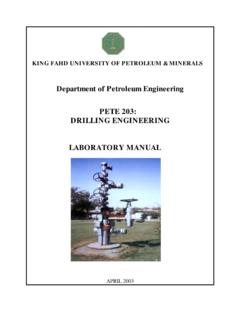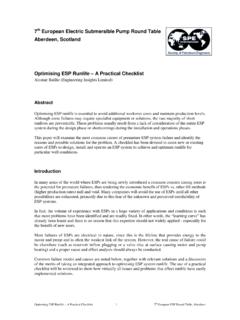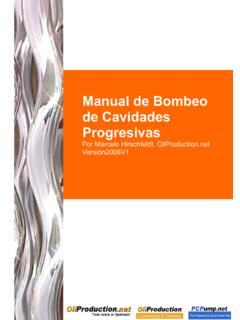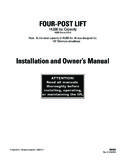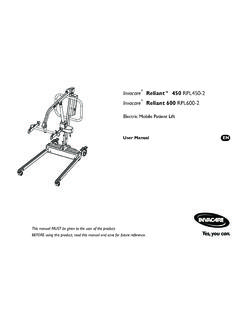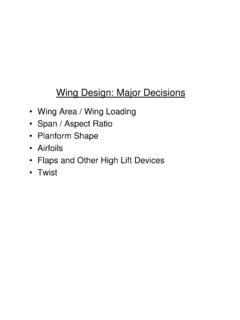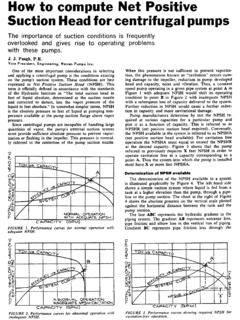Transcription of SPE 124737 Selection Criteria for Artificial Lift …
1 SPE 124737 Selection Criteria for Artificial Lift System Based on the Mechanical Limits: Case Study of Golfo San Jorge Basin Clemente Marcelo Hirschfeldt, Rodrigo Ruiz; SPE, Copyright 2009, Society of Petroleum Engineers This paper was prepared for presentation at the 2009 SPE Annual Technical Conference and Exhibition held in New Orleans, Louisiana, USA, 4 7 October 2009. This paper was selected for presentation by an SPE program committee following review of information contained in an abstract submitted by the author(s). Contents of the paper have not been reviewed by the Society of Petroleum Engineers and are subject to correction by the author(s). The material does not necessarily reflect any position of the Society of Petroleum Engineers, its officers, or members. Electronic reproduction, distribution, or storage of any part of this paper without the written consent of the Society of Petroleum Engineers is prohibited.
2 Permission to reproduce in print is restricted to an abstract of not more than 300 words; illustrations may not be copied. The abstract must contain conspicuous acknowledgment of SPE copyright. Abstract The Golfo San Jorge basin is the oldest productive basin of Argentina, and is located in south Patagonia. With 12,630 active oil wells, the basin produces 269,937 bpd of oil, and MM bdp of water. The Artificial lift systems are distributed as follows: 9,648 Sucker Rod Pumps (SRP), 1,615 Progressing Cavity Pumps (PCP) and 1,336 Electric Submersible Pumps (ESP). There are some important experiences with gas lift, plunger lift and hydraulic jet pump, but are not considered in this study. Close than 90% of the pumps are installed between 3,000 ft to 8,000 ft depth, producing flow rates over 1,500 bpd of fluid More than MMbpd of water are injected in 2,400 wells in water flooding projects, therefore 41% of the oil is produced from this method.
3 Due to the mature state of the basin, every year, new waterflooding projects are implemented for increasing and to hold the oil production of the basin. With every new project, not only increases the gross production per well, but also increases the depth of the new reservoirs. The combination of these factors resulted in a higher power to be transmitted from the prime mover to the pump, coupled with the increasing down hole temperature. Another factor, is the restriction provided by the most common casing diameter (5 ), limiting the outside diameter of the pumps, the tubings and sucker rod sizes, and the shaft diameter too in some systems. In order to overcome these conditions, not only requires new technology in materials and design, but Criteria for operation on the surface to achieve it. This paper presents a theoretical and practical analysis of the mechanical and operational limit of the most used Artificial lift systems in Golfo San Jorge Basin such as the PCP, ESP and SRP.
4 The analysis not only considers the technical aspects of each critical component and new technologies, but also is supported by reservoir information, operational conditions from 11,000 wells and software simulations for each system. One of the main objectives of this paper is to provide a guide for selecting and designing Artificial lift Systems as SRP, PCP and ESP in similar oilfields and conditions. 2 SPE 124737 The Golfo San Jorge Basin The East-West trending Golfo San Jorge basin is the oldest and most prolific oil basin of Argentina It covers 28,000 M Acre, with 1,127 MMbo (Dec-05) of OOIP and is located in the central Patagonia. (Figure 1 -Appendix ) The first commercial oil discovery took place in 1907 and since then close to 2,900 MMBOE were extracted.
5 Located in the central part of Patagonia Terrain, it is an intracratonic extensional basin. During late Jurassic-early Cretaceous times, the extension related to the Gondwana break-up generated many isolated small half-graben basins, with a NW-SE structural trend. Later, a new extensional-transtensional stress field originated a WNW-ESE trending, and reduced extensional deformation continued until the Oligocene. The basin is essentially asymmetric; in the eastern section the dominant extensional faults are on the northern flank with the southern flanks being a less faulted, flexural type margin. In contrast, the western section is asymmetric but its major faults are on the southern flank, being the northern flank a flexural margin. The central section of the San Jorge basin is dominated by NW and NNW trending extensional faults that were reactivated by compression in Tertiary times.
6 Artificial Lift Systems (ALS) in GSJB From the beginning of the activity in Golfo San Jorge Basin, 100 years ago, several ALS have been used in order to produce the oil from each well. The basin offers different conditions depending of the mature state of the oilfields: high water percentage, high and low flow rate, free gas and in solution, heavy and light oil, flowing wells and high GOR reservoirs. At the present time, ALS as SRP, PCP and ESP are the most popular systems used for producing 98 % of the total fluid of the basin. And in smaller quantity, wells produced by hydraulic jet pump, plunger and gas lift. The growing reservoir depth and flow rate of fluid per well, present a permanent challenger for the different ALS and specialist. In this context, the Selection , operation and optimization of the different systems plays one of the most important roles for following the basin development. The follow cross plot represent information from 9,000 wells running in GSJB.
7 0200040006000800010000120000500100015002 00025003000flow rate- bpdpump depth- feetSRPPCPESPSPE 124737 3 Power transmission and mechanical limits The analysis of a production system from the concept of nodal analysis, localizing the node at the Pwf position (Figure 1), separates the systems in two: 1. Inflow: Flow of the fluid trough the reservoir to the well rreservoirwfPPP= .. (1) 2. Outflow: Flow of the fluid from the down hole to the surface, trough the tubing and line pipe seplinepipetubingswfPP PP= .. (2) Depending on the dynamic pressure (pfw), flow rate target and analyzing the pressure required to overcome the pressure drop in the tubings and surface installations, we can analyze if we will need an external system ( Artificial lift system ) to provide sufficient energy to the fluid to overcome these restrictions, and how provide the energy to these systems. (Figure 2), Hydraulic Horse Power To establish a definition of the mechanical limits of the Artificial lift, we must establish a definition of the useful work that an Artificial lift system performs.
8 If it is agreed that the down hole pump does work equal to the volumetric flow rate times the pressure increase delivered by the pump, then the following two equations can be used for a definition of the horse power of an Artificial lift system. 1. lnput horse power to the system (HPin) .. (3) 2. Output horse power to the produced fluid (HPout) D= .. (4) In other words, a more power is necessary to transmit from the prime mover to the pump when the flow rate or/and pressure is increasing Q1 PwfPrinflowoutflowDelta PPwf Pr Psep Pwh Q1 Delta P Figure 1 Figure 2 4 SPE 124737 Power transmission Every ALS presents different elements as power transmitter between the prime mover and the downhole pump, where the mechanical limits of each element is essential for increasing the run life of the systems producing the maximum fluid from the reservoir.
9 During the pumping action, each components of the ALS is subject to various efforts and environmental conditions affecting the performance of each, which there are listed below: - Cyclic loads - Tensional and torsional loads in sucker rods and shafts - Surface structural and torsional loads - Pressure capability of the pumps - Downhole temperature - Frictional effort These efforts may be related to - How the power is transformed from electricity or gas combustion to an alternative or rotational movement. - How this movement is transferred to the pump. - The operational conditions: pumping speed, Stroke length, RPM, pumping pressure - Well geometry and design - And in turn affected by the temperature of bottom In Golfo San Jorge Basin, the main challenge has been how to transfer the horsepower to the pump in 51/2 casing, restricting the maximum tubing, sucker rod, and pump diameter. The Table 1 shows the maximum diameter of each down hole component for 51/2 casing # Energy Flowrate vs Pressure(*) Support torsional, structural and axial load during the pumping.
10 SPE 124737 5 Sucker Rod Pumping The pumping action consists in producing an up and down movement at the surface by a pumping unit, and this movement is transferred by a sucker rod string to the down hole mechanic pump. During this process, the down hole and surface installations are subjected to different loads that limit the lift capacity of the system. The maximum rate of the SRP system is based upon the mechanical limit of three components: sucker rod string, the structure and the reduction gears. But the sucker rod string is normally considered the weak link in a pumping system because of the following limitations: Size restraints (the tubing ID restricts the maximum coupling and sucker rod diameter) Adverse environment Strength limitations During the design process and operation, different combinations of structural and torque ratings, sucker rod design, pump diameter are matched to fit the design in a safety zone for increasing the system run life.

